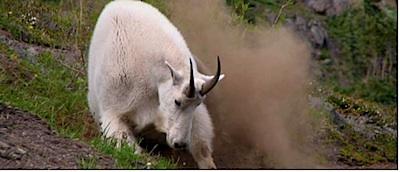
What to do with non-native mountain goats in Olympic National Park?/NPS
Mountain goats are spectacular animals, even iconic in places such as Glacier National Park, but they can cause problems in parks where they don't belong. At Olympic National Park, where a 1920s era introduction project brought non-native goats into the landscape, officials are embarking on a management plan for how to deal with the animals. Adding weight to the need for such a plan was the fatal goring of a hiker in the park four years ago.
Olympic National Park officials long have grappled with what to do with mountain goats.
By the early 1980s, the goat population in the park grew to over 1,000 individuals. Several hundred goats were removed during the 1980s, reducing the population to less than 400 by 1990. The population was stable at approximately 300 goats from 1994'2004, however it was observed to be increasing at a 5% annual rate in 2011. The original need to manage the goat population was driven by ecological concerns related to the impact of goats on the park's natural resources, particularly sensitive vegetation communities. New concerns were raised in 2010 when a visitor was fatally gored by a mountain goat while hiking on a park trail.
With hopes of finding an answer to their goat problem, Olympic officials are preparing an environmental impact statement for a Mountain Goat Management plan. Options range from monitoring goats and dealing with "nuisance" animals to removing all goats from the park through a relocation project or killing them outright. To help develop the EIS, the park staff is seeking suggestions from the public on the issue.
'We are pleased to ask the public to help us develop a long-term plan for managing the population of exotic mountain goats in Olympic National Park,' said park Superintendent Sarah Creachbaum. 'We have drafted some preliminary alternative concepts that we'd like the public to reflect and comment on during this initial scoping period. And of course, we are also interested in additional alternative concepts people may have.'
Mountain goats can be found in a number of parks, though perhaps most famously at Glacier, where they are easily found at Logan Pass. The apparent habituation of these goats to hikers has led to research at Glacier into mountain goat behavior around humans. There also are non-native mountain goats that are creating problems for native bighorn sheep in Grand Teton National Park in Wyoming, some at Yellowstone where they also are considered a non-native threat to park resources, and at North Cascades National Park in Washington's Cascade Range, where they are native.
At Olympic, officails in 2011 instituted a mountain goat management plan, part of which urged hikers not to urinate on trails, as the salty deposits in effect become "long linear salt licks" that lure the goats
Information on the project at Olympic National Park, including the purpose and need for the plan, the plan's objectives and preliminary alternative concepts developed so far, can be found online. You can even submit your comments from that site, or in writing at one of the three open house workshops listed below. Comments may also be mailed to Superintendent, Olympic National Park, 600 East Park Avenue, Port Angeles, WA 98362. Comments should be submitted no later than September 19, 2014.
Public Scoping Open Houses are planned for mid-August as follows:
* Monday, August 11
Seattle Open House 5 p.m. ' 7 p.m.
Seattle Public Library, Wright/Ketchum Room, Level 4, Room 2
1000 4th Avenue, Seattle, WA 98104
206-386-4636
* Tuesday, August 12
Olympia Open House 5 p.m. ' 7 p.m.
Olympic National Forest Headquarters
Willaby-Klahowya-Coho Rooms
1835 Black Lake Blvd Southwest
Olympia, WA 98512
360-956-2303
* Wednesday, August 13
Port Angeles Open House 5 p.m. ' 7 p.m.
Port Angeles Public Library (North Olympic Library System)
2210 S. Peabody Street, Port Angeles, WA 98362
360-417-8500



Comments
http://www.alibris.com/White-Goats-White-Lies-The-Abuse-of-Science-in-Ol...
Please relocate these beautiful animals. National parks are supposed to preserve wildlife, not destroy it. I can't believe it has been suggested that shooting them from helicopters is the safest solution. Is Sarah Palin your director?
This "Old NPS Policy" of attempting to re-create or maintain the dynamic biota which inter-acted during the 1850's or some other period is riddled with flaws:
Even a cursory glance at the landscape shows vegetation is not distributed at random. There are hundreds of scientific studies of paleo-environments and their biota showing how dynamic these communities have been through time. Plants and Animals migrate independently under critical climatic-driven variables; and our ephemeral human perspective is hardly justification to spend scare financial cresources attempting to recreate a landscape "freeze-framed" in time like the "quoted 1850moment" which also happens to be the western America contact date for Europeans vs The Native Peoples.
White Goats, White Lies: The Abuse of Science in Olympic National Park Hardcover - March, 1998
by R. Lee Lyman
Although mountain goats are native to the Cascade range, they do not appear to have been present in Washington states's Olympic Mountains during historic times. Wildlife managers introduced goats in small numbers in what soon became Olympic National Park in 1925 and sporadically thereafter for the next twenty years. According to a 1981 statement by the National Park Service, the mountain goats in Olympic National Park "appear to be significantly altering the alpine ecosystem the park was designed to protect and preserve. As a result, park managers have argued that the goats must be eradicated." An eradication program has been in place for several years now. White Goats, White Lies does not argue for or against eradication of "exotics" in Olympic and other national parks. Rather it examines the science used to justify the current park position and questions the extent to which science is an afterthought in national park decisions.